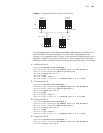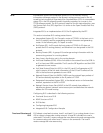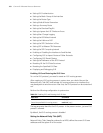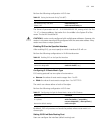
IS-IS 105
IS-IS Intermediate System-to-Intermediate System (IS-IS) intra-domain routing
information exchange protocol is the dynamic routing protocol used in the AS
issued by the International Organization for Standardization (ISO). An intermediate
system (IS) in the OSI reference model is basically equivalent to a router in the
TCP/IP reference model. The IS-IS protocol, based on the link state algorithm, uses
the Shortest Path First (SPF) algorithm. It is similar to the Open Shortest Path First
(OSPF) protocol.
Integrated
IS-IS is an implementation of IS-IS for IP regulated by the IETF.
This section introduces IS-IS routing protocol terms.
■ Intermediate System (IS). An IS equals a router of TCP/IP. It is the basic unit in
the IS-IS protocol used for propagating routing information and generating
routes. In the following text, IS is equal to router.
■ End System (ES). An ES equals the host system of TCP/IP. An ES does not
process the IS-IS routing protocol, and therefore it can be ignored in the IS-IS
protocol.
■ Routing Domain (RD). A group of ISs exchange routing information with the
same routing protocol in a routing domain.
■ Area. Area is the division unit in the routing domain.
■ Link State DataBase (LSDB). All the link states in the network form the LSDB. In
an IS, at least one LSDB is available. The IS uses the SPF algorithm and the LSDB
to generate its own routes.
■ Link State Protocol Data Unit (LSP). In the IS-IS, each IS will generate an LSP
which contains all the link state information of the IS. Each IS collects all the
LSPs in the local area to generate its own LSDB.
■ Network Protocol Data Unit (NPDU). NPDUs are the network layer packets of
ISO and are basically equivalent to the IP packet of TCP/IP.
■ Designated Intermediate System (DIS), is the elected router on the broadcast
network, equivalent to the DR in OSPF.
■ Network Service Access Point (NSAP) is the ISO network layer address. It
identifies an abstract network service access point and describes the network
address for ISO model routing.
Configuring IS-IS is described in the following sections:
■ Two-Level Structure of IS-IS
■ NSAP Structure of IS-IS
■ IS-IS Packets
■ Configuring Integrated IS-IS
■ Integrated IS-IS Configuration Example
Two-Level Structure of
IS-IS
IS-IS adopts a two-level structure, Level-1 and Level-2, in a routing domain (or an
AS) to support a large-scale routing network. A large RD is divided into one or
more areas. The Level-1 routers manage the intra-area routing and are responsible
for communicating with other Level-1 routers in the same area. The Level-2
routers manage the inter-area routing.


















